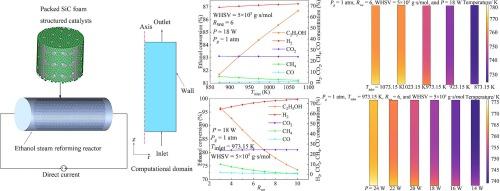直接电加热碳化硅泡沫催化剂上乙醇蒸汽重整的数值模拟
IF 7.5
1区 工程技术
Q2 ENERGY & FUELS
引用次数: 0
摘要
乙醇蒸汽重整(ESR)是一种很有前途的清洁制氢技术。碳化硅泡沫具有优良的导热性和机械稳定性,是一种理想的结构催化剂载体材料。此外,SiC泡沫非常适合作为结构催化剂的导电衬底,有助于焦耳热的集成和ESR的电气化实现。在本研究中,建立了一种新型ESR反应器的计算流体动力学(CFD)模型,该反应器采用直接电加热的SiC泡沫结构催化剂。分析了进口温度(Tinlet)、水乙醇摩尔比(Rwe)、重量小时空速(WHSV)和功率(P)等参数对反应的影响。结果表明,直接电加热时,ESR反应器内的温度分布保持均匀。增加Tinlet、WHSV和P,降低Rwe可显著提高乙醇转化率。此外,SiC的高导热性,结合焦耳加热的直接性质,确保了反应器的轴向温差保持在12 K以下,而径向温差接近于零。虽然填充型泡沫结构催化剂上的乙醇转化率低于包覆型泡沫结构催化剂,但前者表现出更高的氢气出口流速和更低的CO浓度。本文章由计算机程序翻译,如有差异,请以英文原文为准。

Numerical simulation of ethanol steam reforming on structured SiC foam catalyst with direct electrical heating
Ethanol steam reforming (ESR) is a promising technology for clean hydrogen production. Silicon carbide (SiC) foam is an ideal material for structured catalyst carrier due to its excellent thermal conductivity and mechanical stability. Furthermore, SiC foams are well-suited as conductive substrates for structured catalysts facilitates the integration of Joule heat and achievement of the electrification of the ESR. In this present study, a computational fluid dynamics (CFD) model was developed for a novel ESR reactor incorporating SiC foam structured catalysts with direct electric heating. The effects of various operational parameters, including the inlet temperature (Tinlet), water-to-ethanol molar ratio (Rwe), weight hourly space velocity (WHSV), and power (P) were thoroughly analyzed. The results demonstrated that, with direct electrical heating, the temperature distribution within the ESR reactor remained uniform. Increasing Tinlet, WHSV, and P and decreasing Rwe significantly enhanced ethanol conversion. Furthermore, the high thermal conductivity of SiC, in conjunction with the direct nature of Joule heating, to ensure that the axial temperature difference of the reactor remains below 12 K, while the radial temperature difference approaches zero. Although the ethanol conversion on the packed SiC foam structured catalyst was lower than that of the coated SiC foam structured catalysts, the former showed a higher hydrogen outlet flow rate and reduced CO concentration.
求助全文
通过发布文献求助,成功后即可免费获取论文全文。
去求助
来源期刊

Fuel
工程技术-工程:化工
CiteScore
12.80
自引率
20.30%
发文量
3506
审稿时长
64 days
期刊介绍:
The exploration of energy sources remains a critical matter of study. For the past nine decades, fuel has consistently held the forefront in primary research efforts within the field of energy science. This area of investigation encompasses a wide range of subjects, with a particular emphasis on emerging concerns like environmental factors and pollution.
 求助内容:
求助内容: 应助结果提醒方式:
应助结果提醒方式:


